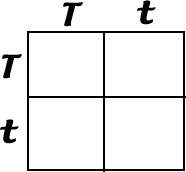How Well Does a Punnet Square Predict Actual Ratios? - Teacher's Guide
Poker chips make easy substitutes. Just use a permanent marker to write T or t on the chips. You can also color code them. I use red chips for the Tt parent and a white chip for the tt parent in part II.
In this lab you will make predictions using Punnet Squares, and then use pennies (or chips) to simulate the crosses. The results from the punnett square can then be compared to the actual data.
The trait you are looking at is the gene that codes for a short big toe in humans.T represents the dominant allele (short big toe), t is the recessive allele, long big toe. The photo shows a person with a short big toe. The following genotypes are possible. Fill in the phenotypes for them
Genotype / Phenotype
T T = _______Short big toe_ (as pictured)_____
T t = _________Short big toe______________
t t = _________Long big toe_________________
Part I
Use a Punnet Square to predict the ratio of offspring in a cross where the parents are both Tt (The Square is set up for you below)
 |
What proportion of the offspring (out of 4) will be: Short Toe__3___ Long Toe _1____ *These are your predicted ratios. These numbers will go in the table below to compare data - 75% and 25% |
Now you will determine the actual ratios by using pennies (chips) to represent the crosses. You have two pennies. One one side of the penny is the letter T, on the other side is the letter t. This penny represents a parent that has the genotype T t. A second penny represents the other parent. One partner is going to play the role of female, the other will play the role of male. When the coin is flipped, you are determining what sperm or what egg is being donated to the match.
Practice flips. Flip the two pennies. The results show you what your offspring will be.
Did you get a TT, a Tt or a tt ? __________ What is the phenotype of your offspring (tall or short?) ____answers vary__
Procedure:
To determine Actual Ratios, you will flip your coins 100 times, recording in the table below how often each combination came up.(Use tally marks to record your data then summarize as a number) - Sample Data only, should be close to a 25/50/25 ratio
| Gene Combination (Genotype) |
Tally
|
Total |
|
TT
|
IIIII IIIII IIIII IIIII | 20 |
|
Tt
|
IIIII IIIII IIIII IIIII IIIII IIIII IIIII IIIII IIIII IIIII IIIII | 55 |
|
tt
|
IIIII IIIII IIIII IIIII IIIII | 25 |
| Phenotypes |
Total
|
| Short toe (add TT + Tt ) | 75 |
| Long Toe | 25 |
Since you flipped one hundred times, your totals above represent a Percentage. Your proportions from the Punnet Square in your prediction can also represent a percentage. ( 1/4 = 25 % 2/4 = 50% 3/4= 75% 4/4 = 100% )
Now compare your predicted ratios to your actual Ratios in the chart below.
| Predicted (from the Punnett Square in Part I) |
Actual (from the flips) | |
| TT | 25 | 20 |
| Tt | 50 | 55 |
| tt | 25 | 25 |
| Short Toe | 75 | 75 |
| Long Toe | 25 | 25 |
Would you consider the predicted values to be the same, close to the same, or not at all the same? _close
Part II
You will repeat the procedure for parents that are Tt and tt
1. First make your predictions by setting up a Punnet square for the parents. (This one is not set up for you)
Tt x tt ----> 1/2 Tt (short toe) and 1/2 tt (long toe)
How many are predicted to be:
Short Toe_50%__
Long Toe__50%___
**Replace one of your pennies (chips) with a t t penny
Perform the flips with your new set of parents. Record your data in the table below. Many students will realize that you only need to flip one of the coins.
|
Tally
|
Total | |
| Tt | should be about 50: 50 for these tosses | 47 |
| tt | (sample data) | 53 |
What percentage of your offspring are Tt ___ What percentage are short toes __
What percentage of your offspring are tt __ What percentage are long toes __
Compare the Predicted Ratios of the cross to the Actual Ratios.
| Predicted (from Square) | Actual (from flips) | |
| Short Toe | 50 | 47 |
| Long Toe | 50 | 53 |
Analysis
1. Why are the Predicted Ratios rarely the same as the Actual Ratios? Because when you flip a coin, there is an element of chance, results get close to the expected values.
2. . Use a Punnet Square to predict the phenotypic ratios in this cross: T T x T t
Short toe _100%__
Long toe _____
3. If you used the coin toss method to determine the actual ratios, would it come out the same? Yes, because there is only one possible outcome
4.What do the pennies or chips represent in the simulation? Pennies represent the gametes (or alleles) of the parents.
5. When you toss the coin to see which side lands up, you are actually simulating what part of the process of sexual reproduction? Which allele or gamete is contributing to the next generation
6. When you put the two coins that are flipped together, you are simulating what part of the process of sexual reproduction? When two gametes (alleles) combine to form a zygote with two alleles
